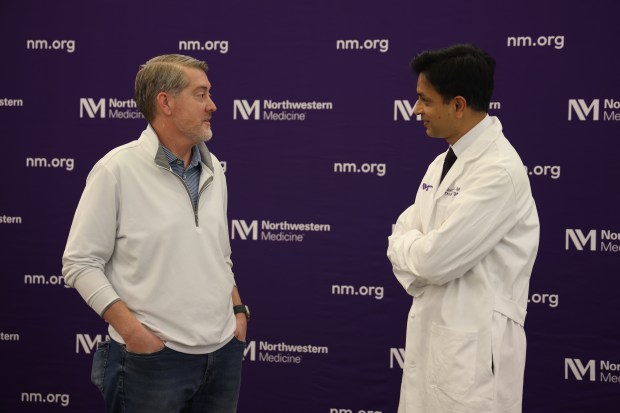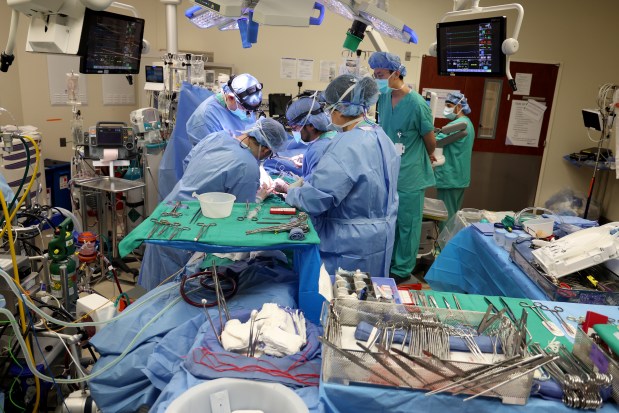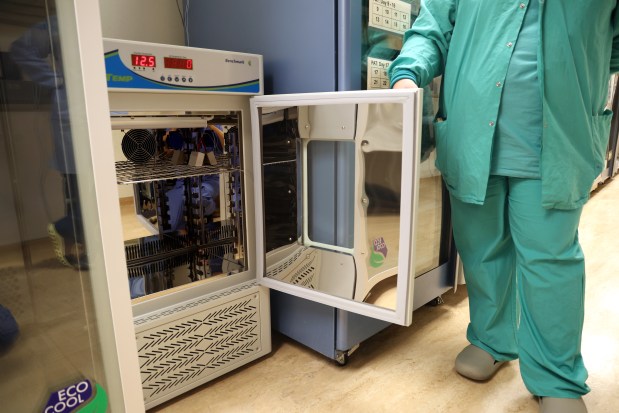The lungs that Dr. Ankit Bharat took out of Tadd Crosslin, a 49-year-old father of twins, were marred with billions of cancer cells.
They were “perhaps the most diseased that we’ve ever seen,” said Bharat, a thoracic surgeon and director of Northwestern Medicine’s Canning Thoracic Institute.
A technology the institute adopted just months ago was a game changer for Crosslin, whose lungs were fused so tightly to his chest cavity that doctors needed extra time to delicately remove them.
The innovative technology, a lung refrigerator, was used in a dozen of the 148 lung transplants the Chicago health system performed in 2024. These days, it’s being used in “pretty much every” transplant.
“It’s going to become the new norm,” Bharat said during a news conference at Northwestern Medicine’s Streeterville campus last week.
Health workers used to have a window of roughly six hours to complete a lung transplant.
Within that timeframe, all of the following had to be completed: extracting lungs from a donor perhaps states away, packaging the lungs, taking them to a local airport, flying them to Midway Airport, taking them to Streeterville, removing the old lungs and putting in the new ones.
Now, when donor lungs arrive in Streeterville, they can be placed in a refrigerator set at 50 degrees Fahrenheit and be kept “alive” in the fridge for up to 18 hours. The fridge is a game changer for a slew of reasons.
The fridge allows the health system’s organ procurement team to travel greater distances for lungs, increasing access to donor lungs and thus shrinking wait times for transplant patients, according to Dr. Ambalavanan Arunachalam, a pulmonologist with the thoracic institute who also spoke at the news conference. When donor lungs can be stored until doctors are ready to tranplant them, more time can be spent getting the lungs to Chicago.
The fridge also enables more flexible transplant scheduling.
Lung transplants previously would occur in the middle of the night, when health workers likely weren’t at their best.
“If the procurement team arrives at 1 a.m. with the donor lung, we can now put the lungs in the fridge and wait to do the transplant at 7 a.m.,” Arunachalam said. “This way, the team can operate after a full night’s rest, which helps with the success rate and reduces the chance of errors.”
The “tough hours” of lung transplant surgery used to inspire fewer surgeons to go into the field, causing a “significant shortage” of thoracic surgeons, according to Bharat. But more interest in lung transplants may be another positive change thanks to the fridge technology.
Additionally, prior to the fridge, donor lungs would be stored on ice which was about 39 degrees Fahrenheit. Bharat said the ice would damage the lungs sometimes.
“Finally, double lung transplants are one of the most complex medical procedures in health care,” Arunachalam said. “Lung refrigeration gives surgeons more time to remove the diseased lungs.”
Both the cancer-ridden lungs and lymph nodes of patients with advanced cancers need to be removed. Surgeons must wash the airways and chest cavity to clear away the cancer before putting in new lungs. And they have to make sure a single cell doesn’t spill into a patient’s chest cavity or blood stream.
Crosslin, who is married and from the Dallas-Fort Worth area, was diagnosed with Stage 3 colorectal cancer in 2016 at the age of 40, and it advanced to Stage 4 by 2019.

While he was undergoing chemotherapy and surgery, pulmonary nodules — areas of abnormal growth in the lungs — were found. Soon, Crosslin had hundreds of tumors on his lungs and difficulty breathing.
“Since I graduated to Stage 4 in 2019, I’ve sought out medical opinions and consults all over the nation. … I even consulted with some surgeons in Germany, and again was turned down,” Crosslin said. “Chemotherapy was my only option to extend my life — that was until I discovered Northwestern’s DREAM program.”
According to Northwestern Medicine, patients with cancer were not able to receive lung transplants historically. But the DREAM program, which is only a few years old, provides double-lung transplants to people with advanced cancers who are not responding to conventional treatments.
Crosslin received his new lungs in September and is remaining in Chicago for 12 months after the surgery so his medical team in the city can closely monitor and care for him, he said.
“It’s only four and a half months … but based on all the metrics that are available to us, we don’t see any cancer left in him,” Bharat said.
Since the transplant, Crosslin has been taking it easy, he said. He’s been down to the Navy Pier and explored downtown. But Chicago is quite colder than Texas, and he’s still getting acclimated.
When it gets a little warmer, Crosslin plans to check out a Cubs game.
Crosslin said that years ago, he decided he wasn’t going to allow cancer to impact the rest of the time he has left. He has maintained full-time employment throughout his battle with cancer, recently starting with a construction company after spending 25 years at AT&T.
“July of (2024) is the last time I’ve done any type of chemotherapy,” Crosslin said. “And after five and a half years of it straight, this has been fantastic — it’s the best I’ve felt in years.”

The 148 lung transplants the health system performed last year were the most it has ever done in a year. And now Northwestern Medicine is the highest volume lung transplant center in the U.S., according to the health system. More than 600 transplants have been performed since the health system launched its lung transplant program in 2014.
About 70% of lung transplants at Northwestern Medicine are double lung transplants, Bharat said.
In 2024, the median wait time for a lung transplant at the health system was four days, which “to our knowledge” is a world record, Bharat said. Often centers have waitlists spanning months.
A different technology adopted at Northwestern Medicine about four years ago, ex vivo lung perfusion, was key to the health system attaining such a small median wait list time, Bharat said.
The lung perfusion technology, referred to as “lungs in a box” technology, repairs donor lungs that initially were not usable for transplants.
“Now we are able to, you know, take those lungs out of that donor, lungs that are not usable, put it on these artificial platforms that we have at Northwestern and then start to treat those problems,” Bharat said. “So for example, we can treat infections. We can treat blood clots in the lungs. We can sometimes treat some of the limited contusions that the person may have had.”
Health professionals are getting better and better at repairing lungs virtually every day, Bharat said.
Each year about 3,000 lung transplants are performed in the U.S. In contrast, about 27,000 kidney transplants were performed in 2023, according to the U.S. Health Resources and Services Administration.
Bharat said fewer lung transplants are performed because they are considered “highly complex.” Based on estimates, the U.S. needs to perform more than 30,000 transplants yearly to serve patients that have advanced lung diseases or malignancy, Bharat said.
“The field, frankly, is just taking off,” Bharat said.



